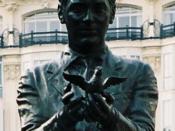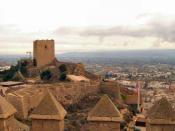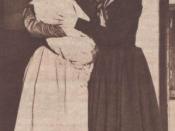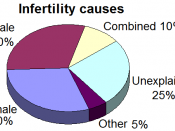Throughout the play 'Yerma', the themes of fertility and infertility are woven into the characters' dialogue and action; this is especially prevalent during the washerwomen scene, act 2, scene 2. It is therefore important for the overall design of the staging space to reflect the desperation of Yerma and her barrenness. The perception of the audience is important in the choice of set design, I would therefore direct 'Yerma' in the round as this will allow for close and personal relationships to form between the characters on stage and the audience. This is especially important in this scene as I wish for the audience to feel like members of the community and involved in the gossip.
As I am setting 'Yerma' in the round, it is important to have a simple and central focus for the audience, this would be a large sandpit, as this represents both the physical dryness of the setting, the drought of the Andalusia landscape, and the barrenness of Yerma, as is said in the women's song, 'Alas, for the barren wife! / Alas for her sand filled breasts!' the sand is therefore a literal representation of the metaphor in their song.
Throughout the play, characters remove sand; this would show the passing of time and with it, the passing of Yerma's hopes to have a child. During the washerwomen's scene, the sand would be covered by a fluid stretch of material blue/green in colour that represents the water in which the women are washing. The cloth would stretch across the whole stage area and create a stream running through the centre splitting the washerwomen in half. The play as a whole would be lit with powerful orange, red and white lights to enhance the feelings of barrenness, this lighting is juxtaposing this with blue and green lighting, that highlights the desolation of the rest of the play.
The costumes that the washerwomen wear are important in showing their characters and contrasting their freeness with the restrictions forced on Yerma and the personalities of Juan's sisters. The washerwomen would wear greens, earthy browns and white or cream, colours that suggest fertility and would have been worn in the 1930s; the women have a regular uniformity to their costumes that creates a feeling of them all being the same. It is suggested that all the women are mothers and in their song, the line 'How she shines!' describes how the women should look, glowing, animated and very active. To stand out from the rest and still look as though she is a part of the same community, Yerma would wear yellow instead of green, signifying the lack of fertility. All the women would be barefoot to show that they are poor; they would all wear long skirts and shawls, some with long-sleeved blouses, others with short. I would dress the two sisters in black, their costumes would be loose and not show their figures, the costumes resemble the dress of nuns as they are religious, 'They used to keep an eye on the Church. Now their keeping an eye on the sister-in-law.' Their appearance in the middle of the scene changes the tone from an argument over Yerma's situation to a false discussion about sheep; their materialization is like a curse that follows them so they have to have a very strong presence, without speaking, they take control of the scene and create an atmosphere in which they are comfortable, they are controlling of other characters, not just Yerma.
The use of levels shows the status and relationships between characters. The most powerful impressions on the audience are given before any lines are spoken, when the characters enter. In this scene, I would have some of the characters entering singing, and the rest of the women moving about the stage. I would want to create a busy atmosphere and so would have the women continuously creating action. The appearance of more women throughout the first half of the scene would create a claustrophobic feeling such as the one Yerma experiences at home with the sisters. With so many people on stage, there is an issue with blocking, but this does not matter, as it is in the round, constant action means that there will always be something to watch even if it is not the character speaking. In this scene, the characters should interact with the audience as though they were members of the community, reacting to the gossip heard. Once the sisters enter, the stage area becomes a different place, women that are not speaking leave the stage space and there is obvious difference in status between the remaining women and the sisters. The sisters remain standing, removed from the small group of women who are kneeling at the water's edge. From this it is clear that the sisters have power over everyone because everyone is afraid of them.
The physical appearance of the sisters is authoritative, they are dominant figures whose movement is very proper, they glide slowly rather than walk or stride, and stand upright with superior bearing to the village people. This places them above the villagers and gives them the appearance of being more important than those around them. The women have no pride in their posture and do not carry themselves with the sophistication of the sisters; they are working people and move freely. This freedom shows the restriction of Yerma. The sisters do not move except for a purpose, their movements are larger than those of the ordinary people and are abstract, highlighting the fact that they do not fit in with the people.
The second half of the scene is stylised, a ritualistic feeling is created through the rhythmical banging of drums off stage and the beat created by the women through repeated actions and the lines of their song which has a prominent beat, exaggerated by the enunciation of the women. Each woman repeats a sequence of 4 moves, these start quite naturalistic and build up in intensity, likewise, the beating of a drum starts soft and distant and becomes more powerful and threatening. Each gesture is one associated with washing; one woman might wring out a piece of cloth, shake it free and then dip it into the river twice. To start with, this is very realistic, it becomes more menacing when exaggerated and performed with a vicious temperament. The women would have props, pieces of cloth to wash and baskets to carry on stage with them. The props are realistic and so in tone with the play as a whole.
The naturalistic setting of the play is important, written and set in the 1930s, Lorca focuses on the ordinary people and ordinary situations. His feelings of social isolation are passed onto his characters as they struggle with their lives. The feelings of Yerma and Juan are highlighted in this scene where neither of them appears. Juan is paranoid that the people in the village are gossiping about him and is worried about them saying anything, the audience sees in this scene that his fears are the case and that he is the talk of the village because of what he and his wife are doing. Yerma's fear is in not having a child, the topic of conversation and the theme of the song that the women sing, it was at this time important to have children to carry on a legacy and to assist with the running of the family's business in the case of Yerma and Juan, shepherding. Yerma is a social out cast, similar to Lorca himself; Lorca based the characters in his play upon himself to some degree, telling the account of the outcast and of individuals in pain.
I believe that this scene should be accompanied musically. As previously mentioned, a drum is essential for creating tension with the chanting, earlier in the scene, there is a naturalistic feel to the scene. To create the very traditional Spanish atmosphere that I feel is necessary to represent the landscape and the views and opinions offered, I would have a Spanish guitar playing. Traditional music would be played to represent the countryside and the outdoors where the play is set. The musicality of this scene will create a liveliness and freedom that Yerma does not experience.
Lorca treats the washerwomen as a chorus from a Greek play. They continue the narrative through announcing the arrival of the sisters and transposing the play further forwards in time. They speak chorally, or chant chorally to create an effect of a building up of intonations. They also interact primarily with the audience, providing a comic break from the serious nature of the narrative; this is again another role of a chorus, to give the audience a sense of involvement, of experiencing first hand.
I believe that the most important aim of this scene is to create a sense of contrast by juxtaposing the fertile, watery fluidity of this scene with the dry, barren set and theme running through the rest of the play. In this sense, this scene is the most important scene as it creates the feelings of desolation through the audience's ability to have perceived reality as well as the world through Yerma's eyes as the rest of the play shows. This allows them to feel sympathetic for Yerma and empathise with her situation. Lorca's creation of lost, lonely, isolated characters expresses his own life, upbringing and perception of his time; it also represents something in everyone watching his plays, for them, Yerma's plight is a representation of something universal. Solitary figures do not appear in this scene, they are not part of the society, they do not exist to the washerwomen but to an audience, they are at the back of the mind, linked to any reference, any contrast in the set, action or characters disposition.





